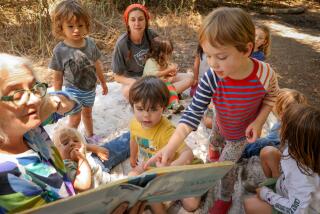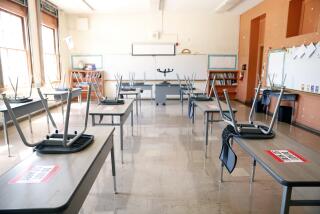Teaching Mountain Youths to Learn : Students Schooled in Confidence
- Share via
DAVID, Ky. — For Mike Hopkins, who wouldn’t ask his teachers questions last year, his new school is a revelation.
Now the 16-year-old eastern Kentuckian and his teachers call each other by first names and talk like friends.
Schoolmate Jeff Potter, 17, described a similar transformation: “Before I came here, every year I had nothing but straight Fs. I came up here and I’m making straight A’s and Bs.”
For the 60 students at the David School, just attending marks a big change. Most are from low-income mountain families. They found public schools overwhelming and abandoned any hope of educational success. Half had dropped out of school.
Now Draws Attention
But the small, private school in a former coal company store has made a difference, even in an area where the 1980 census indicated that nearly four of every 10 people 18 to 24 years old finished three years or less of high school.
Now it is drawing the attention of groups seeking secrets of inspiring students who drop hopelessly behind and sparking participation by those who shrink from the crowd.
Jean Ford, a teacher who moved to the area in 1972 after teaching literacy in Jamaica, and Daniel Greene, a sociology student from Brooklyn, N.Y., started the school in 1974.
Combining regular classes of not more than six or seven students, cleanup and fix-up work around the school and vocational training in a school-owned food market and gas station, the school has educated more than 500 youths, said Greene, the director. Of the 19 graduated this spring, 16 are slotted for higher-education programs.
No Secret Methods
Greene said there are no secret methods. “The greatest challenge we’re faced with is developing self-confidence.”
The school calls on students’ parents to help the 15-member staff turn around attitudes of hopelessness that Greene said often haunt the hills and hollows of the eastern Kentucky coal fields. The families do not have long-range goals. “They do not have much feeling of self-worth,” he said.
And the children are ill-prepared for immersion in large public schools. Ninety-five percent of Greene’s students are from low-income families and, he said, “Many of them are hollow kids; they’ve never eaten out or been to a bowling alley.
“Kids come here saying, ‘I hated the principal, I hated the teachers, I’m flunking out.’ What they really mean is, ‘Nobody’s giving me any attention,’ ” Greene said.
At David, the student must enroll voluntarily and is consulted about where to start and how to progress academically. Parents are not only consulted but participate in school activities, including a fall carnival, and are visited by teachers once a month at home.
Makes People Feel at Home
“It starts with making the children and their parents feel real at home here. The kids become very vocal about who they are, where they want to be,” Greene said.
The teachers, all with master’s degrees or above, pay close attention to each student.
One recent day, in one of the small, second-floor classrooms in the former commissary building the school shares with the one-room David post office, math teacher Mary Jo Seig sat at a table with five students.
The students worked in their texts, at different levels, and she helped first one, then another. “We’re doing fractions, percents, algebra and trigonometry.”
In another room, Dick Hastings explained redox (reduction and oxidation) equations chalked on the blackboard for one chemistry student.
Devote More Attention
Outside, sitting on a sidewalk in the sun, Beth Segal conducted a study period in health and social issues for four junior high students.
“In public school if you have a problem they mark it wrong and hand the paper back,” Hopkins said.
“Here, they mark it wrong and sit down with you,” Potter said.
Rules are few, Greene said. “They’re asked to respect the rights of others, come to school straight and sober. Very basic things.”
There’s no custodial budget, so everybody works--washing dishes, mopping floors, fixing leaks and repairing window panes. “It makes them feel that this is their place,” resulting in an almost a total lack of vandalism, he said.
Students gain social confidence, especially on skating or bowling trips and dances at the school. The change in students, Greene said, is “amazingly fast.”
‘Everybody Gets Along’
“People are amazed that we have all these kids here who were dropouts. And it’s quiet. It’s peaceful. Everybody gets along.”
“We have a girl, 15, who had been in 6th grade for three years,” Ford said. “It was a losing battle. We put her on an individual program and she’s turned into a real little adult, making up the program. She told me today she wants to be a doctor. Maybe she won’t, but now she has this dream.”
Greene also has a dream--to expand services to mountain children who have given up on school. The David School started with high school classes. A preschool started in 1983, and this year junior high classes were offered.
Conducts Equivalency Program
The school also conducts a high school equivalency diploma program that serves nearly 100 people in the area.
Greene spends 60% of his time traveling to raise money from churches, individuals and some corporations, which provides half the school’s $189,000-a-year budget. Eighty percent of the donations come from outside Kentucky, he said.
Students, being mostly from low-income families, are billed only $5 to $20 a month, depending on income.
More to Read
Sign up for Essential California
The most important California stories and recommendations in your inbox every morning.
You may occasionally receive promotional content from the Los Angeles Times.













